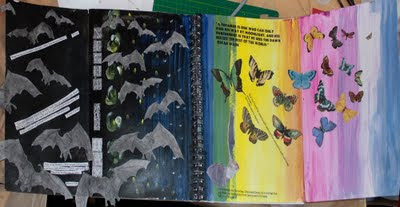Dry point is a technique known as intaglio where the image was drawn on an acetate sheet using a sharp pointed tool.
You can add texture with dots, cross hatching etc.
I put an acetate sheet over a sketch I did of a romantic lady surrounded by butterflies.
Water based printing ink was spread onto a glass plate and evened with a roller and this was applied to the acetate. The ink needs to be scrubbed into the lines and the excess removed with scrim or a soft rag.
The acetate went face down in the printing press between newsprint on top of well dampened paper and the image - reversed - was then printed.
I used the same technique for the leaf prints which I intended to scan to use as digital backgrounds. The second image has had an extra coating of ink rolled on after the plate had been prepared for printing.
Chine-collé
Chine-collé is a wonderful technique for adding colour and texture to a dry point print. We added light weight papers, fabric, and text to the prepared acetate plate. These additional pieces were laid right side down and then the backs of the added papers were covered in glue (using just an ordinary glue stick).
On the printing press the plate was laid on top of newsprint and the dampened paper for the final print was placed on top of it. More newsprint was laid on and the print went through the press.
The collaged papers become part of the print with the printed lines on the plate showing through the collage paper.
This is a really interesting technique and I am going to a Practice your Printing workshop on May 6th with some ready prepared acetate sheets to try out some more ideas!























